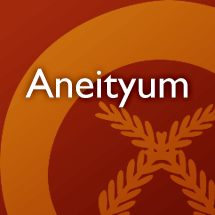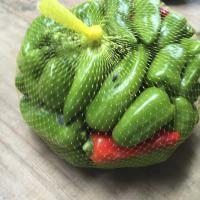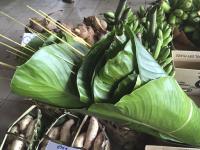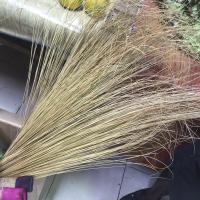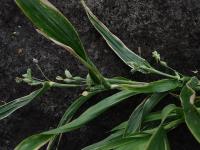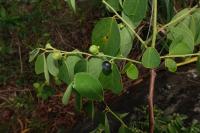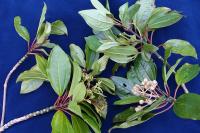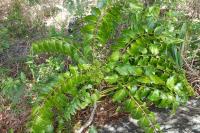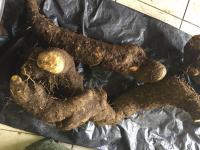An example search has returned 100 entries
aelan panadol
aiyu
adj. sweet; shady
bookmarkauhorohos
v. to weed; to clear land
bookmarkelgai
v.n. expand as a leaf
bookmarkincowos
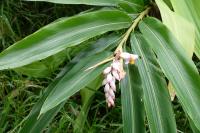
n. herb to 1. 5 m, flowers white with pink tips. Growing on sandy path along coastal walk to ute. (collection: Michael J. Balick #4989)
Example: The leaves of this plant are used to finish the ridge of the house roof. Lay the leaves horzontally on top of the roof, and the sides of the roof are thatched with palms or grass. Layer 10 leaves on top of each other to enable this part of the roof (known as nitjintiniom) to last for a long time--perhaps up to 6 years. If this is used on the top of a roof where there is a fire burning, such as a kitchen, and this leaf gets a lot of smoke, it can last much longer a the top of the roof--perhaps 10 years or more.
bookmarkingaije
n. kind of tree
bookmarkinhodaig et ecro
n. astronomy word, no def. given--possibly referring to a common shellfish "inhudaig". no def. for "ecro" or any feasible alternate spellings.
bookmarkinjivij
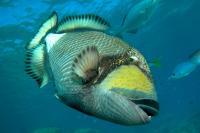
n. Titan triggerfish
Example: Photo by Leonard Low, License: CC BY-NC 3.0 via Fishes of Australia
bookmarkinridjai
n. kind of plant, grass, or fern
bookmarkintal has
n. kind of taro
bookmarkintapin
n. a hedge; a shelter
bookmarkintit plen
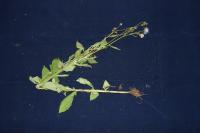
n. herb, growing on roadside in open disturbed area. (collection: Gregory M. Plunkett #3605)
Example: 1a. This is an invasive weed that was brought to Aneityum by aircraft. Name means "aircraft mess". 1b. Means “planes waste” refers to white trails as this has lots of white seeds that fly.
bookmarkinwoapeñ

inyipei
n. the flour, as of arrowroot
bookmarkinyitupau
n. kind of tree
bookmarkjigkom
[ʧiŋkum] n. chewing gum
bookmarkmac
n. cup (mug)
bookmarkmuri muri
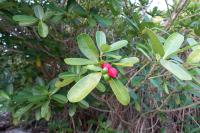
nagag ~ nacag
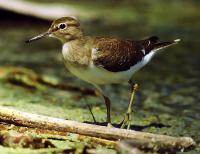
nagereta
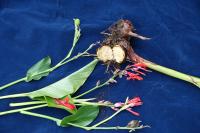
nahad
n. kind of plant, grass, or fern
bookmarknahed u paralecei
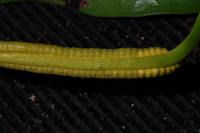
nahmas
n. kind of plant, grass, or fern
bookmarknaligaj
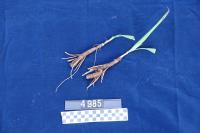
n. herb to 10 cm, sterile (collection: Michael J. Balick #4985)
Example: This plant is a very important food during a famine. People dig up the roots and roast these on the embers of a fire for 25 minutes, then check the root to get out the starchy material, and spit out the fiber. There is said to be little taste; this is a bland food that a person eats to survive. People on Aneityum have harvested it for a very long time so there is not as much of a supply left as in the past.
bookmarknamesei
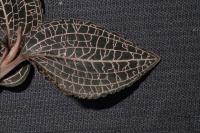
napayu
n. kind of tree
bookmarknapdaj
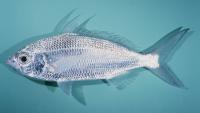
napua
n. kind of taro
bookmarknariramteh
n. kind of banana
bookmarknasahas
n. a small water-plant
bookmarkneaig
n. the kernel of a coconut; the coconut tree
bookmarkneduon yau
n. kind of banana
bookmarknelkasau
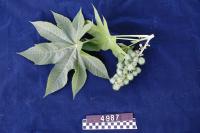
n. shrub to 4 m, fruits green (collection: Michael J. Balick #4987)
Example: This leaf is used as the upper layer of leaves on the earth oven. If the leaves of #4986 are in short supply, people cover the first layer of stones in the earth oven with these. The stems of this plant are used as tinder to light fires. The seeds are poisonous.
bookmarknepigpig
n. before daylight
bookmarknerin
n. a leaf
bookmarkneroa
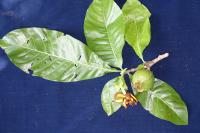
n. tree, 6-7 m tall (collection: Gregory M. Plunkett #3527)
Example: 1. The flower is used to make a necklace and the wood used as poles for a house roof. The flower is very fragrant and people put it behind their ear to enjoy the aroma. The leaf is used to bake taro in the earth oven. Use a fire to heat stones, then when the fire burns down and the stones are hot, pile these leaves on top of the hot stones and then place the food being cooked--taro, fish, pig, cassava, banana or other foods--on top of the leaves. Then pile more of these leaves on top of the food and then place additional hot stones on top of that pile of leaves. While the food is cooking--each type of food takes a different amount of time--the leaves give off a very nice smell and help flavor the food. 2. Firewood, flower smells good, put in coconut oil to give it aroma. Grate coconut, add small amount of water, put in bowl, heat until water is evaporated, the oil is on top, take all the coconut cream on bottom save oil in another pot. Drop 2-3 flowers into coconut oil and boil, or more flowers. Try not to burn the oil. Take out flowers and use pure oil. Also used for final covering of large earth oven during feast along with GMP 3503 – esp. wedding feast. Planting pole and hard and heavy wood – sharp end. 3. This is a "calendar plant." When it flowers, people know that the taro is ready to harvest.
bookmarknetcetas
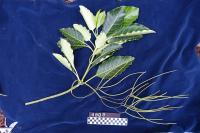
netcetas
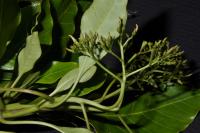
n. well branched tree, 15 m tall (collection: Gregory M. Plunkett #4084)
Example: 1. The name means "explosion". Further information about the plant withheld.
bookmarknethedwoleg
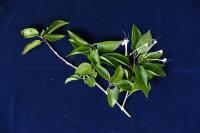
n. shrub, 1. 5 m tall (collection: Gregory M. Plunkett #3557)
Example: For treatment of a stomach ache, or if your stomach "complains", take very young stems, break off the leaves and chew the stems and swallow the juice. Use a 3-5 cm pieces of stems, chew, and then it clears your intestines and will make you go to the toilet.
bookmarknidi yebeg
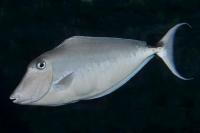
n. Humpback unicornfish
Example: Photo by Ross D. Robertson / Shorefishes of the Neotropics, License: CC BY-SA 3.0 via Fishes of Australia
bookmarknigirid
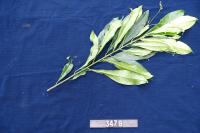
n. tree, 2 m tall (collection: Gregory M. Plunkett #3479)
Example: The leaves of this plant are used in cooking, particuarly with the earth oven. Use a fire to heat stones, then when the fire burns down and the stones are hot, pile these leaves on top of the hot stones and then place the food being cooked--taro, fish, pig, cassava, banana or other foods--on top of the leaves. Then pile more of these leaves on top of the food and then place additional hot stones on top of that pile of leaves. While the food is cooking--each type of food takes a different amount of time--the leaves give off a very nice smell and help flavor the food. The young stems of this plant are used in home construction but as they are small and thin, they are not used for posts.
bookmarknihivaeñ aeyec
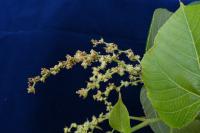
n. tree, 3 m tall (collection: Gregory M. Plunkett #3213)
Example: 1. When a person has a headache from being out in the sun too long, scrape the outer bark off of the stem of this tree, take scrapings of the inner bark, wrap with a leaf of breadfruit and put in a fire for 15-20 minutes. Not a hot fire, but only in the flame. Squeeze the water out of the bark when it is warm and rub all over the forehead and face to help the headache go away. 2. Use the stems of this tree as a stick to carry taro from the field, as the stick is strong but not too heavy. The taro is tied to each end to balance on a person’s shoulders. 3. Leaf used for wrapping local medicines. This is the best leaf and put it on the charcoal to heat it. 4. Good firewood.
bookmarknijcel
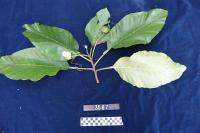
n. tree, 7-8 m tall (collection: Gregory M. Plunkett #3587)
Example: 1. If the preferred banana leaves are not available to wrap food for cooking, then use young leaves of this species and tie taro and fish for cooking. 2. Use leaves to wrap fresh water prawns and fresh water fish and cook them on charcoal. Use as a cup by making funnel out of leaf and drink from it. 3. Used for unspecified ritual activities.
bookmarknilcasau
n. the castor-oil plant
bookmarknipʧin niri
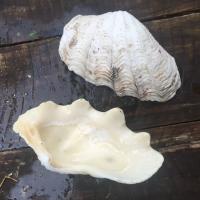
niridunumu
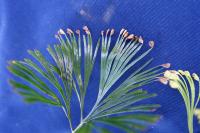
nisiug
n. a tree, the leaves of which have no center rib
bookmarknohwai itai
n. berry
bookmarknohwan nefara
n. kind of taro
bookmarknokoko
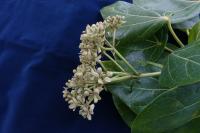
n. large well branched tree, 18-20 m tall (collection: Gregory M. Plunkett #3216)
Example: 1. The trunk of this plant is used to make canoes. 2. It is also a good timber for the inside part of houses. 3. Mix the sap from the stem with other unspecified leaves and rub them into dreadlocks. 4. To attract shells in the sea, scrape a branch and drop in the sea where shells are attracted to the branches and they can be collected for sale to the Island’s visitors. 5. Seeds are used to make beautiful black necklaces. Said to be a lot of work as it is difficult to remove the seed. Rub with sandpaper or soak in water and then make the hole in the seed. 6. Fruit is a children’s toy – used as a whistle to make a nice sound.
bookmarknopna
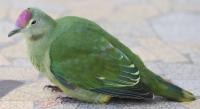
[nopɲa] n. Red-Bellied Fruit Dove
Example: Sub-adult Red-bellied Fruit Dove. Photo by Papier K / Wikimedia Commons, License: CC BY-SA 3.0 via Wikimedia Commons
bookmarknoporo pora
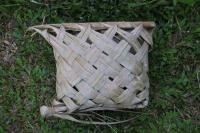
nopugei
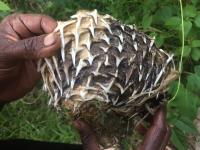
tarere
adv. near; inshore; near the shore
bookmarkuriicai
adj. made of branches
bookmarkwakas
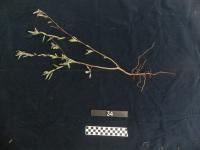
n. herb. Found along intra village path. (collection: Ashley A McGuigan #34)
Example: 1. To make baby grow strong - Take 16 tops of the plant, no flowers, and squeeze them into baby’s bath water. Bath baby in the water and let it dry on the baby. Don’t towel dry. 2. Medicine – take a large leaf, crush and rub it but don’t break it – just soften it and open it and cover the fresh cut with it – leave it there to heal the wound. Keep changing it until the wound gets healed. 3. For headache and fever – flu – take branches with no flowers or seeds, boil it 15 minutes to extract brownish juice, drink 1 cup hot 2, per day – morning and evening for 5 days. 4. The fruits – 7 – chew and swallow for stomachache. 5. Tie stems for broom.
bookmarkwamhau
n. kind of taro
bookmarkwidinahau
n. kind of banana
bookmarkyasua
n. kind of taro
bookmark